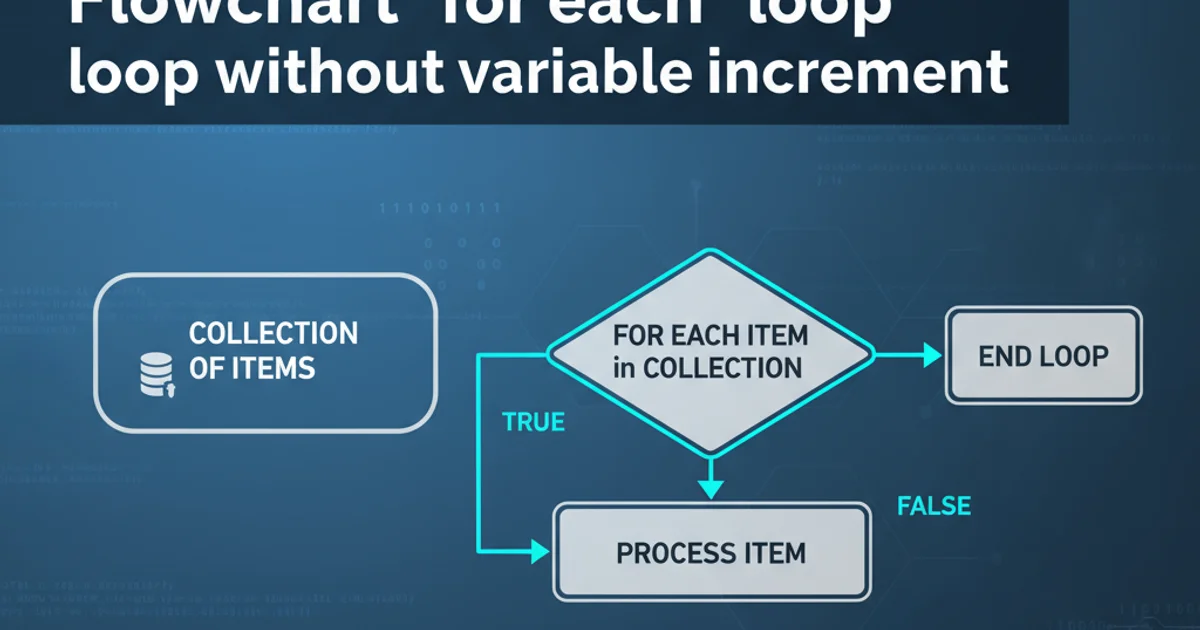Flowchart "for each" loop loop without variable increment
Categories:
Mastering 'For Each' Loops in Flowcharts Without Explicit Increments

Explore how to effectively represent 'for each' loop logic in flowcharts, focusing on implicit iteration over collections without needing a separate increment variable.
Flowcharts are powerful tools for visualizing algorithms and processes. While traditional 'for' loops often involve an explicit counter that increments with each iteration, 'for each' loops operate differently. They iterate directly over elements within a collection (like an array or list) without the need for a manual index or increment variable. This article will guide you through representing this distinct 'for each' loop behavior in your flowcharts, ensuring clarity and accuracy.
Understanding the 'For Each' Loop Paradigm
A 'for each' loop, also known as an enhanced for loop or a foreach loop, simplifies iteration by directly providing each item from a collection in turn. The underlying mechanism handles moving to the next item and determining when the collection has been fully traversed. This abstraction means that in a flowchart, we don't typically show a separate 'increment counter' step, as it's an internal detail of the loop construct itself. Instead, the focus is on processing the 'current item' and checking if 'more items exist'.
flowchart TD
A[Start]
B["Initialize Collection (e.g., List of Items)"]
C{"Are there more items in the collection?"}
D["Get next item from collection"]
E["Process current item"]
F[End]
A --> B
B --> C
C -->|Yes| D
D --> E
E --> C
C -->|No| FBasic flowchart for a 'for each' loop without an explicit increment.
Key Components of a 'For Each' Flowchart
When designing a flowchart for a 'for each' loop, several key components are essential to accurately represent its behavior:
- Initialization: This step involves defining or retrieving the collection that will be iterated over. This could be an array, list, set, or any iterable data structure.
- Loop Condition: Instead of checking an index against a maximum value, the condition for a 'for each' loop is typically 'Are there more items in the collection?' or 'Is the collection exhausted?'. This decision point determines whether the loop continues or terminates.
- Get Next Item: This implicit step represents the loop construct fetching the next available item from the collection. It's crucial to show that a new item is made available for processing in each iteration.
- Process Item: This block contains the core logic that operates on the 'current item' obtained from the collection.
- Loop Back: After processing, the flow returns to the loop condition to check for more items.
Example: Processing a List of User Names
Let's consider a practical example where we need to iterate through a list of user names and perform an action for each. The flowchart will clearly show the 'for each' logic without any explicit counter management.
flowchart TD
A[Start]
B["Define `userNames` List"]
C{"Are there `userNames` remaining?"}
D["Get `currentUser` from `userNames`"]
E["Display `currentUser`'s profile"]
F[End]
A --> B
B --> C
C -->|Yes| D
D --> E
E --> C
C -->|No| FFlowchart for processing a list of user names using a 'for each' loop.
In this example, the userNames list is initialized. The decision block "Are there userNames remaining?" handles the loop termination. If yes, "Get currentUser from userNames" implicitly moves to the next user, and "Display currentUser's profile" represents the action. The flow then loops back to check for more users. This structure accurately reflects the 'for each' paradigm.